tow MERCEDES-BENZ SLK ROADSTER 2008 Service Manual
[x] Cancel search | Manufacturer: MERCEDES-BENZ, Model Year: 2008, Model line: SLK ROADSTER, Model: MERCEDES-BENZ SLK ROADSTER 2008Pages: 273, PDF Size: 4.42 MB
Page 228 of 273
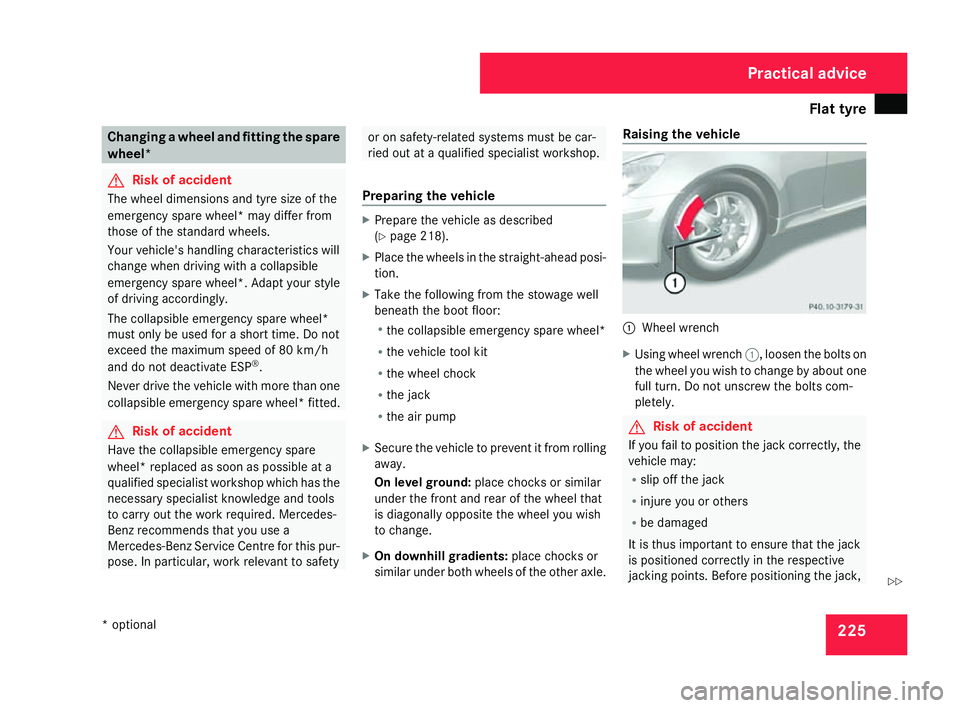
Flat tyre
225Changing a wheel and fitting the spar
e
wheel * G
Risk of accident
The wheel dimensions and tyre size of the
emergency spare wheel* may differ from
those of the standard wheels.
Your vehicle's handling characteristics will
change when driving with a collapsibl e
emergency spare wheel*. Adapt your style
of driving accordingly.
The collapsible emergency spare wheel*
must only be used for a short time. Do not
exceed the maximum speed of 80 km/h
and do not deactivate ES P®
.
Never drive the vehicle with more than one
collapsible emergency spare wheel* fitted.G
Risk of accident
Have the collapsible emergency spare
wheel* replaced as soon as possible at a
qualified specialist workshop which has the
necessary specialist knowledge and tools
to carry out the work required. Mercedes-
Benz recommends that you use a
Mercedes-Benz Service Centre for this pur-
pose. In particular, work relevant to safety or on safety-related systems must be car-
ried out at a qualified specialist workshop.
Preparing the vehicle X
Prepare the vehicle as described
(Y page 218).
X Place the wheels in the straight-ahead posi-
tion.
X Take the following from the stowage well
beneath the boot floor:
R
the collapsible emergency spare wheel*
R the vehicle tool kit
R the wheel chock
R the jack
R the air pump
X Secure the vehicle to prevent it from rolling
away .
On level ground :place chocks or similar
under the front and rear of the wheel that
is diagonally opposite the wheel you wish
to change.
X On downhill gradients: place chocks or
similar under both wheels of the other axle. Raising the vehicle
1
Wheel wrenc h
X Using wheel wrench 1, loosen the bolts on
the wheel you wish to change by about one
full turn. Do not unscrew the bolts com -
pletely. G
Risk of accident
If you fail to position the jack correctly, the
vehicle may :
R slip off the jack
R injure you or others
R be damaged
It is thus important to ensure that the jack
is positioned correctly in the respective
jacking points. Before positioning the jack , Practical advice
* optional
171_AKB; 3; 4, en-GB
vpfaff7,
2007-11-13T10:50:25+01:00 - Seite 225 Z
Page 231 of 273
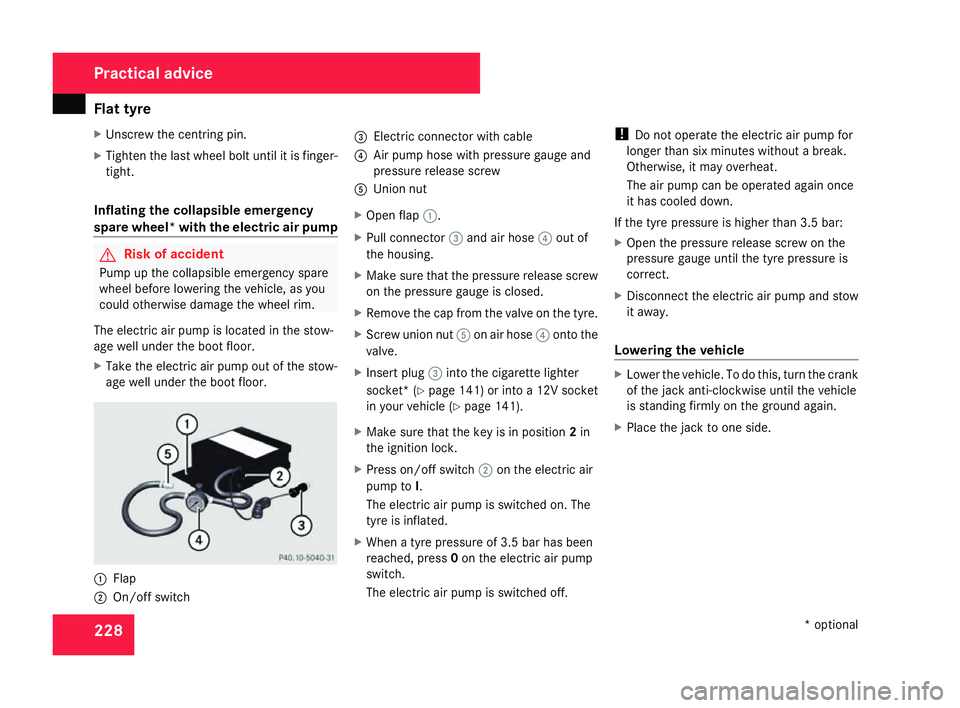
Flat tyre
228
X
Unscrew the centring pin.
X Tighten the last wheel bolt until it is finger-
tight .
Inflating the collapsible emergency
spare wheel* with the electric air pump G
Risk of accident
Pump up the collapsible emergency spare
wheel before lowering the vehicle, as yo u
could otherwise damage the wheel rim.
The electric air pump is located in the stow -
age well under the boot floor.
X Take the electric air pump out of the stow-
age well under the boot floor. 1
Flap
2 On/off switch 3
Electric connector with cable
4 Air pump hose with pressure gauge and
pressure release scre w
5 Union nut
X Open flap 1.
X Pull connector 3and air hose 4out of
the housing.
X Make sure that the pressure release screw
on the pressure gauge is closed.
X Remove the cap from the valve on the tyre.
X Screw union nut 5on air hose 4onto the
valve.
X Insert plug 3into the cigarette lighter
socket* (Y page 141 )or into a 12V socket
in your vehicle (Y page 141).
X Make sure that the key is in position 2in
the ignition lock .
X Press on/off switch 2on the electric air
pump to I.
The electric air pump is switched on. The
tyre is inflated.
X When a tyre pressure of 3.5 bar has been
reached, press 0on the electric air pump
switch.
The electric air pump is switched off. !
Do not operate the electric air pump for
longer than six minutes without a break.
Otherwise, it may overheat.
The air pump can be operated again once
it has cooled down.
If the tyre pressure is higher than 3.5 bar:
X Open the pressure release screw on the
pressure gauge until the tyre pressure is
correct.
X Disconnect the electric air pump and stow
it away .
Lowering the vehicle X
Lower the vehicle. To do this, turn the crank
of the jack anti-clockwise until the vehicle
is standing firmly on the ground again.
X Place the jack to one side. Practical advice
* optional
171_AKB; 3; 4, en-GB
vpfaff7
, 2007-11-13T10:50:25+01:00 - Seite 228
Page 232 of 273
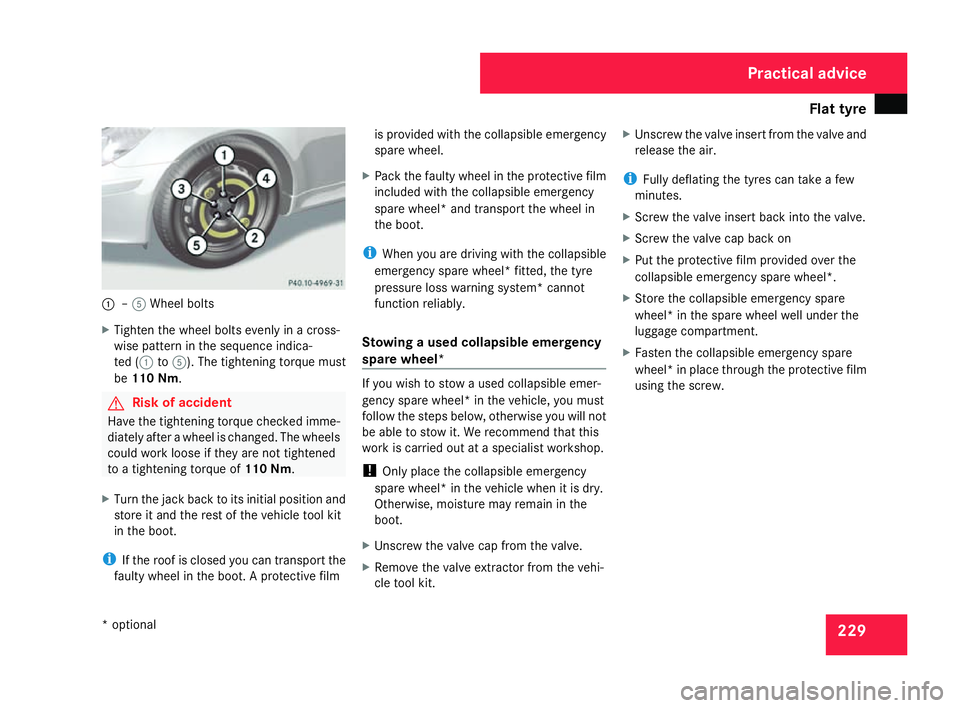
Flat tyre
2291
–5 Wheel bolts
X Tighten the wheel bolts evenly in a cross-
wise pattern in the sequence indica-
ted (1 to5 ). The tightening torque must
be 110 Nm. G
Risk of acciden
t
Have the tightening torque checked imme-
diately after a wheel is changed. The wheels
could work loose if they are not tightened
to a tightening torque of 110 Nm.
X Turn the jack back to its initial position and
store it and the rest of the vehicle tool kit
in the boot.
i If the roof is closed you can transport the
faulty wheel in the boot. A protective film is provided with the collapsible emergency
spare wheel.
X Pack the faulty wheel in the protective film
included with the collapsible emergency
spare wheel* and transport the wheel in
the boot .
i When you are driving with the collapsible
emergency spare wheel* fitted, the tyre
pressure loss warning system* cannot
function reliably.
Stowing a used collapsible emergency
spare wheel* If you wish to stow a used collapsible emer-
gency spare wheel* in the vehicle, you must
follow the steps below, otherwise you will not
be able to stow it. We recommend that this
work is carried out at a specialist workshop.
!
Only place the collapsible emergency
spare wheel* in the vehicle when it is dry.
Otherwise, moisture may remain in the
boot.
X Unscrew the valve cap from the valve .
X Remove the valve extractor from the vehi -
cle tool kit. X
Unscrew the valve insert from the valve and
release the air.
i Fully deflating the tyres can take a few
minutes.
X Screw the valve insert back into the valve .
X Screw the valve cap back on
X Put the protective film provided over the
collapsible emergency spare wheel*.
X Store the collapsible emergency spar e
wheel* in the spare wheel well under the
luggage compartment.
X Fasten the collapsible emergency spar e
wheel* in place through the protective film
using the screw. Practical advice
* optional
171_AKB; 3; 4, en-GB
vpfaff7,
2007-11-13T10:50:25+01:00 - Seite 229
Page 237 of 273
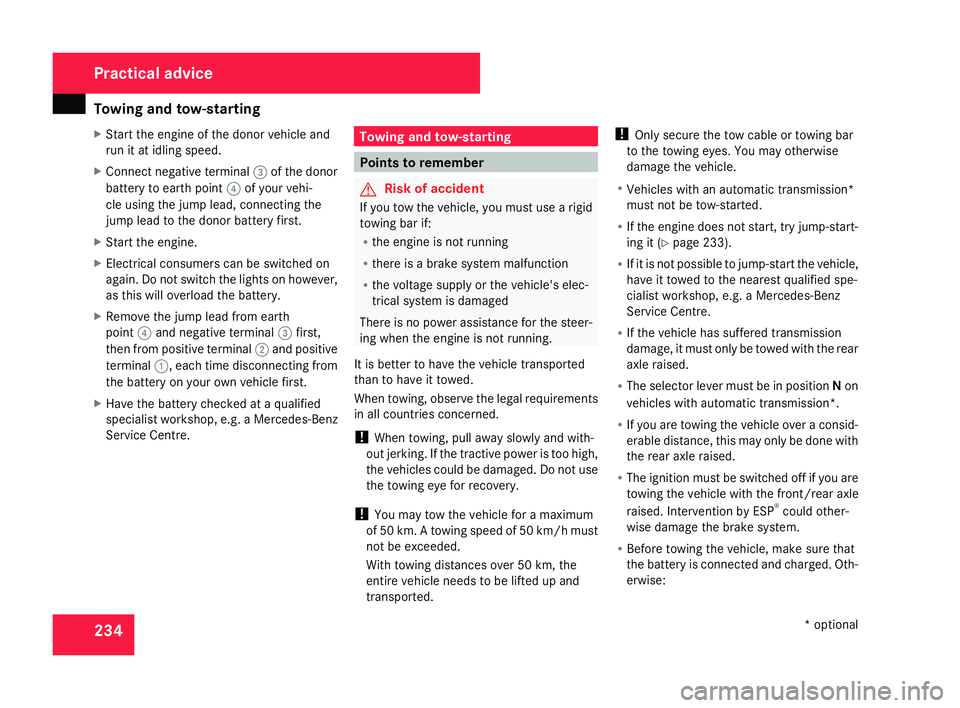
Towing and tow-startin
g234
X
Start the engine of the donor vehicle and
run it at idling speed .
X Connect negative terminal 3of the donor
battery to earth point 4of your vehi-
cle using the jump lead, connecting the
jump lead to the donor battery first.
X Start the engine.
X Electrical consumers can be switched on
again. Do not switch the lights on however ,
as this will overload the battery.
X Remove the jump lead from eart h
point 4and negative terminal 3first,
then from positive terminal 2and positiv e
terminal 1, each time disconnecting from
the battery on your own vehicle first .
X Have the battery checked at a qualified
specialist workshop, e.g. a Mercedes-Benz
Service Centre. Towing and tow-starting
Points to remember
G
Risk of accident
If you tow the vehicle, you must use a rigid
towing bar if:
R the engine is not running
R there is a brake system malfunctio n
R the voltage supply or the vehicle's elec-
trical system is damage d
There is no power assistance for the steer-
ing when the engine is not running.
It is better to have the vehicle transported
than to have it towed.
When towing, observe the legal requirement s
in all countries concerned.
! When towing, pull away slowly and with-
out jerking. If the tractive power is too high,
the vehicles could be damaged. Do not use
the towing eye for recovery.
! You may tow the vehicle for a maximum
of 50 km. A towing speed of 50 km/h must
not be exceeded.
With towing distances over 50 km, the
entire vehicle needs to be lifted up and
transported. !
Only secure the tow cable or towing bar
to the towing eyes. You may otherwise
damage the vehicle.
R Vehicles with an automatic transmission*
must not be tow-started.
R If the engine does not start, try jump-start-
ing it (Y page 233).
R If it is not possible to jump-start the vehicle ,
have it towed to the nearest qualified spe-
cialist workshop, e.g. a Mercedes-Ben z
Service Centre.
R If the vehicle has suffered transmission
damage, it must only be towed with the rear
axle raised.
R The selector lever must be in position Non
vehicles with automatic transmission*.
R If you are towing the vehicle over a consid-
erable distance, this may only be done with
the rear axle raised.
R The ignition must be switched off if you are
towing the vehicle with the front/rear axle
raised. Intervention by ESP ®
could other-
wise damage the brake system.
R Before towing the vehicle, make sure that
the battery is connected and charged. Oth-
erwise : Practical advice
* optional
171_AKB; 3; 4, en-GB
vpfaff7,
2007-11-13T10:50:25+01:00 - Seite 234
Page 238 of 273
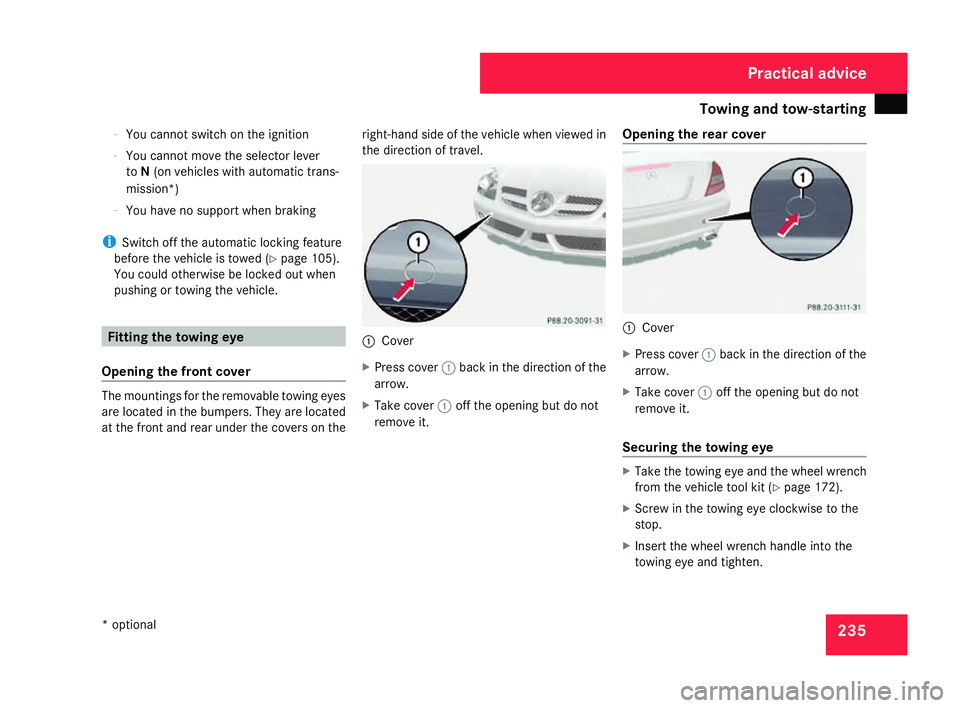
Towing and tow-startin
g 235
-
You cannot switch on the ignition
- You cannot move the selector lever
to N(on vehicles with automatic trans-
mission*)
- You have no support when braking
i Switch off the automatic locking feature
before the vehicle is towed (Y page 105).
You could otherwise be locked out when
pushing or towing the vehicle. Fitting the towing eye
Opening the front cover The mountings for the removable towing eyes
are located in the bumpers. They are located
at the front and rear under the covers on the
right-hand side of the vehicle when viewed in
the direction of travel. 1
Cove r
X Press cover 1back in the direction of the
arrow.
X Take cover 1off the opening but do not
remove it. Opening the rear cover 1
Cove r
X Press cover 1back in the direction of the
arrow.
X Take cover 1off the opening but do not
remove it.
Securing the towing eye X
Take the towing eye and the wheel wrench
from the vehicle tool kit (Y page 172).
X Screw in the towing eye clockwise to the
stop .
X Insert the wheel wrench handle into the
towing eye and tighten. Practical advice
* optional
171_AKB; 3; 4, en-GB
vpfaff7,
2007-11-13T10:50:25+01:00 - Seite 235
Page 239 of 273
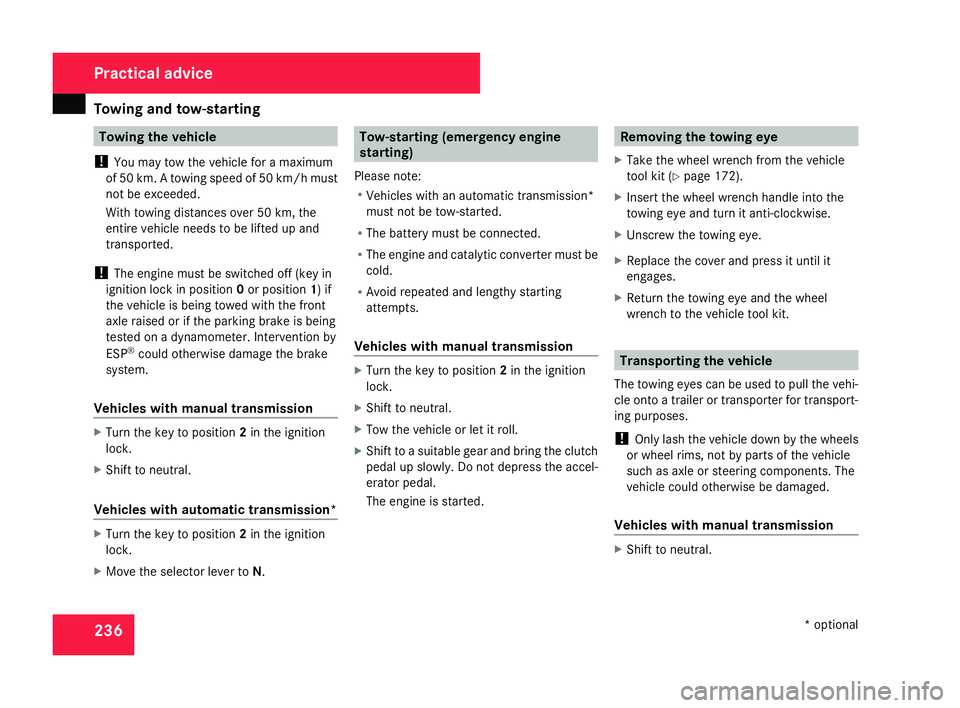
Towing and tow-startin
g236 Towing the vehicle
! You may tow the vehicle for a maximum
of 50 km. A towing speed of 50 km/h must
not be exceeded.
With towing distances over 50 km, the
entire vehicle needs to be lifted up and
transported.
! The engine must be switched off (key in
ignition lock in position 0or position 1) if
the vehicle is being towed with the fron t
axle raised or if the parking brake is bein g
tested on a dynamometer. Intervention by
ESP ®
could otherwise damage the brake
system.
Vehicles with manual transmission X
Turn the key to position 2in the ignition
lock .
X Shift to neutral .
Vehicles with automatic transmission *X
Turn the key to position 2in the ignition
lock .
X Move the selector lever to N. Tow-starting (emergency engine
starting )
Please note:
R Vehicles with an automatic transmission*
must not be tow-started.
R The battery must be connected.
R The engine and catalytic converter must be
cold.
R Avoid repeated and lengthy starting
attempts .
Vehicles with manual transmission X
Turn the key to position 2in the ignition
lock .
X Shift to neutral .
X Tow the vehicle or let it roll.
X Shift to a suitable gear and bring the clutch
pedal up slowly. Do not depress the accel-
erator pedal.
The engine is started. Removing the towing ey
e
X Take the wheel wrench from the vehicle
tool kit (Y page 172).
X Insert the wheel wrench handle into the
towing eye and turn it anti-clockwise.
X Unscrew the towing eye.
X Replace the cover and press it until it
engages.
X Return the towing eye and the whee l
wrench to the vehicle tool kit . Transporting the vehicle
The towing eyes can be used to pull the vehi-
cle onto a trailer or transporter for transport-
ing purposes.
! Only lash the vehicle down by the wheels
or wheel rims, not by parts of the vehicl e
such as axle or steering components. The
vehicle could otherwise be damaged.
Vehicles with manual transmission X
Shift to neutral . Practical advice
* optional
171_AKB; 3; 4, en-GB
vpfaff7,
2007-11-13T10:50:25+01:00 - Seite 236